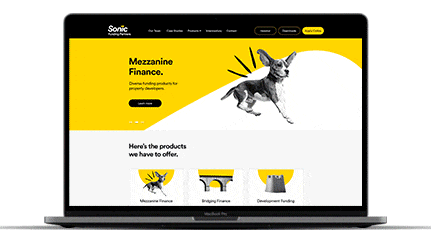Elevate Your Brand With Spectacular and User-Friendly Website Design
In today's digital landscape, a well-crafted web site offers as the keystone of a successful brand strategy. By incorporating aesthetic charm with user-friendly navigating, organizations can boost customer experience and foster long-term links. As we check out the important components of efficient site style, it comes to be clear that the risks are greater than ever before.
Importance of Site Layout
Website layout is important in today's electronic landscape, where roughly 75% of individuals judge a company's reputation based on its web site appearances. A properly designed website not only captures attention but also fosters trust and encourages user engagement. In an era where online interactions are critical, companies can not afford to neglect the impact of design on user understanding and behavior.
Efficient site design works as the structure for a brand name's on the internet existence, influencing customer experience and retention prices. A visually enticing and practical site can distinguish a brand from its rivals, improving its market position. A thoughtfully designed website can simplify navigating and improve the accessibility of details, which is essential for maintaining visitors and lowering bounce rates.
Moreover, the relevance of site design expands past looks; it includes the integration of receptive design concepts that deal with various tools. As mobile use continues to climb, making sure that a site works seamlessly throughout all systems is necessary for getting to a more comprehensive target market. Finally, focusing on web site design is not simply an issue of visual appeal; it is a tactical critical that straight impacts an organization's success in the electronic globe.
Key Components of User-Friendly Style

Receptive designs make certain that the internet site operates flawlessly throughout different tools, from desktop computers to smart devices. This flexibility is crucial in today's electronic landscape, where customers gain access to web sites through multiple systems.
In addition, clear phone calls to action guide customers toward desired outcomes, whether that be purchasing, enrolling in a newsletter, or contacting the business. These motivates must be prominently presented and quickly identifiable, making use of contrasting shades and compelling language.
Furthermore, accessibility attributes, such as alt text for images and key-board navigation options, are essential in making the website usable for people with specials needs. By integrating these crucial elements, organizations can develop an easy to use site that not only boosts site visitor contentment yet additionally motivates see this engagement and conversions.
Visual Allure and Branding
Visual allure plays an important duty in establishing a brand name's identification and promoting a connection with users. A properly designed web site reflects the core worths and personality of a brand, developing an immediate perception that can affect user understanding and involvement. Visual aspects such as color plans, typography, and images collaborate to connect click here for more the essence of a brand, making it remarkable and recognizable.
Constant visual options throughout all systems reinforce brand identification and add to a cohesive experience for customers. A luxury brand name may choose for a minimal style with low-key shades and elegant fonts, while a dynamic startup may accept strong shades and lively graphics. These choices not just share the brand name's message but also evoke particular feelings and organizations that resonate with target market.
Moreover, aesthetic charm can set apart a brand in a saturated market. A visually striking web site can draw in interest and invite exploration, establishing a brand aside from competitors. Inevitably, the integration of aesthetic charm within internet site design is necessary for constructing brand name commitment and trust, as it functions as a structure for a solid, lasting relationship in between the brand name and its audience.

Enhancing Customer Experience
A well-crafted design not just records focus however also dramatically enhances user experience, ensuring site visitors can navigate a website effortlessly and contentment. Crucial element such as instinctive navigation, responsive designs, and clear phone calls to activity are important in guiding customers with the web site perfectly. When users can find information quickly and easily, their general fulfillment boosts, fostering a favorable connection with the brand.
Furthermore, including visual hierarchy aids to direct individuals' emphasis to one of the most important material, making it easier for them to understand the website's offerings. Constant use of shades, fonts, and images reinforces brand name identity while producing a natural experience that resonates with visitors.
Furthermore, optimizing tons times is essential; Continued slow-moving websites can cause aggravation and greater bounce prices. Prioritizing mobile-friendliness makes sure that users accessing the website from different tools have an uniform experience, even more boosting usability.
Determining Success and Influence
Success in site style can usually be evaluated with numerous metrics that disclose the impact of user experience on visitor actions. Key performance signs (KPIs) such as bounce price, ordinary session period, and conversion rate offer important insights into exactly how properly a website engages its users. Website Design. A high bounce rate may indicate that visitors are not discovering what they expect, indicating the requirement for layout renovations or material improvement
In addition, tracking customer communications through tools like heatmaps and session recordings can illustrate how site visitors browse the website, highlighting locations that require optimization. If customers consistently forget a call-to-action button, it might require repositioning or upgrading for much better visibility.
In addition, gathering individual responses via studies or functionality testing can help recognize discomfort points in the user journey. This qualitative information matches quantitative metrics, providing an alternative view of site efficiency.
Inevitably, gauging success and effect in web site style includes a combination of analytical tools and individual understandings. By constantly assessing these metrics, companies can make enlightened decisions that enhance user experience and foster brand loyalty.
Conclusion
In final thought, reliable site layout serves as a crucial element for brand name elevation in an affordable digital landscape. Eventually, a well-executed internet site design not only identifies a brand yet also significantly affects its on-line presence and success.